Fire Department History
Over 180 years of fire protection
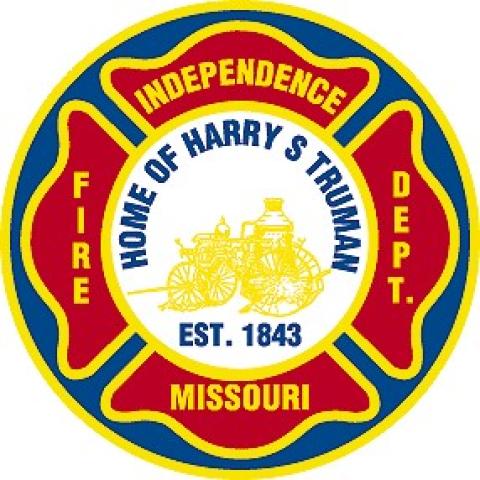
The City of Independence, MO is known for being a historic, all-American city and home of the 33rd President of the United States, Harry S Truman. The Independence Fire Department played a significant role in that history. Established in 1843, IFD is the oldest fire department west of the Mississippi River. Rich in history and tradition, we pride ourselves on being a traditional fire department, remaining true to its roots, while maintaining the flexibility to make the changes necessary to meet the demands of a modern, ever-changing city. Consisting of 10 fire stations, 15 apparatus, and a staff of 190 dedicated personnel, IFD provides high quality fire protection, fire prevention and emergency services to the citizens and visitors of our city, all day, every day.
The following is an overview of the history of the Independence Fire Department, written by former IFD member Jerry L. Hall. It was written over 30 years ago, after hundreds of hours of library research. He and others formed the Harry S. Truman, Independence 76 Fire Company Historical Society, the organization dedicated to preserving the history of the Independence Fire Department. Without them, much of our history would have been long forgotten and equipment from bygone eras, lost to time and the elements. IFD history and several of these resurrected artifacts can be experienced in person at the Independence 76 Fire Company Museum, located in the basement of old IFD Station 1, at 220 N. Lynn St., Independence MO.
150 YEARS OF FIRE PROTECTION
“doing the best they could”
In the early 1840’s, Independence was a pioneer village on the verge of becoming a booming, wealthy outfitting, and trading community. It had become the county seat in 1827. The 1830’s courthouse square was surrounded by one and two story wooden and brick buildings housing general stores, traders, blacksmiths and wagonmakers. There were a couple of hotels and several saloons. Pioneers were rubbing shoulders with visionaries. The need for more churches and schools was becoming apparent. It was becoming a town of families and merchants. As these people dug in and planted their roots, they realized they had a real stake in the town. They realized they needed to protect themselves from the ravages of fire and conflagration.
In 1843 Richard Ridgeway Rees, James McGill, Anthony Cosgrave, Benjamin Franklin Wallace and thirty-six others petitioned the state legislature for incorporation as the “Independence Fire Company”. The Twelfth General Assembly approved, and the volunteer fire company became incorporated by state law on February 6, 1843.
This group of civic minded volunteers may have been highly motivated, but they were ill equipped for their mission. They set out to do battle with fire armed only with buckets, axes, and hooks.
Soon after the city was incorporated in 1849, it experienced several large fires around the public square. In 1850 a fire ignited gunpowder stored in a warehouse on the west side of the square. The resulting explosion and fire killed one man and threatened to consume the town. In 1852, a livery stable fire killed one man and twenty-six horses.
Soon afterwards the following item appeared in the Independence Occidental Messenger – “When shall we have our fire engine for which the legislature was so kind as to give us $1400 to buy it with? More than three years have elapsed since the appropriation was made, and yet no engine has been seen. There has been shameful neglect somewhere.”
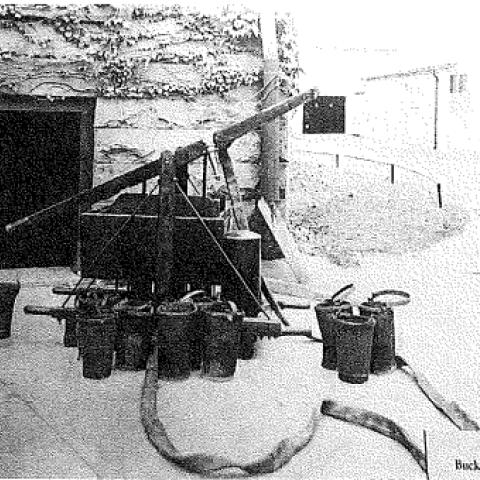
By December 9, 1853, Independence had a fire engine. When the city ordinance was passed incorporating the “Independence Fire Company” into the body politic, it also gave them possession and control of the city fire engine “The Independence 76” and the building which later became known as “The Engine House”.
“Independence has not always had a paid fire department or even a hose cart. Many now living here remember very well when there was no water works and the fire protection consisted of a hand force pump, commonly called a “mankiller”. There were two long arms at which a number of men could stand at either end of the big engine and when this engine was working with a dozen strong men it would throw a large stream of water about as far as the water works will throw it now. There were four fire cisterns, one at each side of the public square and at the engine house was a well of living water. The latest engine which was used until the water works was installed, cost the city $3,000 and was brought here on a boat [1860], being hauled up from the Wayne City landing. The arrival of the new engine was a day of celebration. The volunteer department donned helmets and uniforms and marched around the square with the new machine which shone with brass and polished wood. The old engine and the new were tried and the new engine threw a stream of water over the top of the courthouse tower and the town was considered to have a wonderful fire protection. When the hose cart and water works took the place of the old force pump engine it was stored in a building on the market square which was burned and the old engine destroyed.”
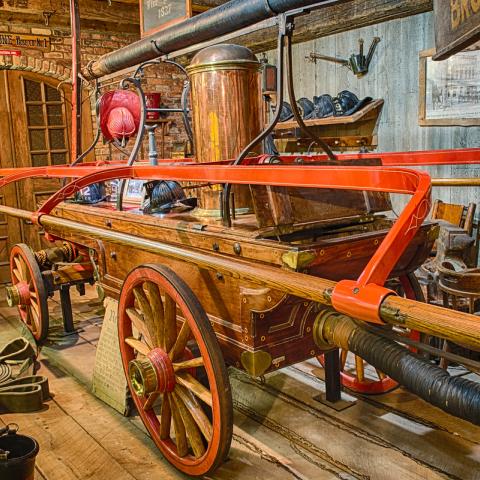
From the time of the civil war until the arrival of the water works in the 1880’s, very little is known of organized fire protection in Independence. It was a time of terrible destruction followed by a determined rebuilding effort. One of the original founders, Benjamin Franklin Wallace, became mayor in 1869. It seems likely that the volunteer fire company was reorganized along with the other civic enterprises.
The “water works” and its accompanying hydrants signaled the end of manpowered pumping engines and the beginning of the hose wagon era. The firemen no longer controlled the water pressure by using their own pumping engine. They arrived at the scene of a fire with hoses and nozzles which they would attach directly to the fire hydrants. Their ability to throw a stream was dependent upon the amount of water pressure and flow available from the hydrants. This dependency upon hydrant pressure contributed greatly to the loss of the First Christian Church on South Pleasant in October of 1918. The hose wagon era began during the 1880’s and lasted until 1928. It included man pulled, horse drawn and motorized hose wagons. It witnessed the end of the volunteer era and the beginning of the paid department in 1894.
The first modern fire engines were a pair of 1928 American LaFrance pumpers. The steering wheel was on the right side and chains, not driveshafts, transferred
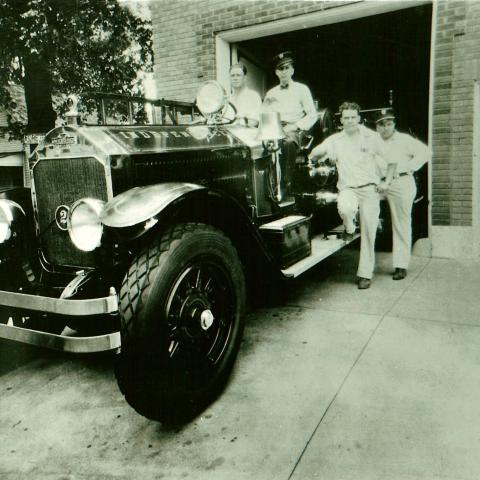
power to the rear wheels. The acquisition of these pumpers; the reopening of Firehouse No. Two; the restoration of the second fire company which had been out of service for eight years; and a building/fire code was in direct response to a fire department rehabilitation program “introduced” by the Missouri Inspection Bureau.
A pair of 1949 Seagrave pumpers finally replaced the venerable 1928 American LaFrance’s. The city’s decision to purchase these Seagrave pumpers was precipitated by the public’s call for an investigation of the
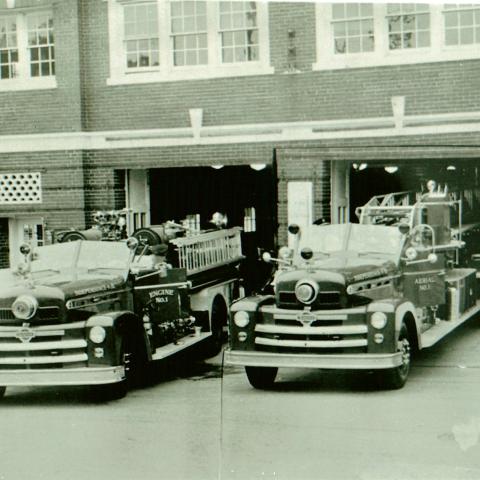
fire department following two disastrous fires on the Independence Square. The first occurred on January 20th as Harry S Truman was being sworn in as President of the United States. It caused $500,000 damage and burned out nearly an entire block of South Main Street. The second square fire on April 5th resulted in $200,000 damage. Both fires required the assistance of neighboring departments to control.
The City Council passed a resolution which stated in part..."That the fire and water committee of the Council make a thorough investigation of the fire department as to the personnel and their qualifications as firemen, and the equipment and its adequacy under present conditions; that the committee report its findings and recommendations to the Council.”
This investigation and another rehabilitation program initiated by the Missouri Inspection Bureau, guided the department into the growth period of the 1950’s. It began that decade with 12 firemen and 2 stations protecting a population of 16,000. It found itself in the early 1960’s with more than 100 firemen and 8 stations protecting nearly 100,000 citizens. During the 1950’s and 1960’s the department boasted that it was as well-equipped and well trained as any comparable sized department in the country. The newspaper articles of those days seem to verify this and also show that the department had a successful public relations program.
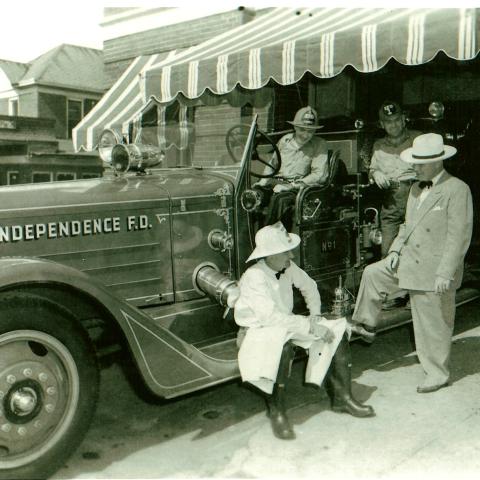
While the 1950’s and 1960’s were a period of rapid expansion for the entire community, it was also a unique time of pride and progress for the fire department Under the caring tutelage of Mayor Robert P. Weatherford, Jr., and veteran Fire Chief Thomas J. Pollard, it became a truly professional, dedicated, and innovative organization. The firemen rode out on a matched fleet of the latest Seagrave engines and a Seagrave ladder truck. These rigs carried equipment that reflected the latest advances in modern fire apparatus. The firemen were trained in the latest firefighting techniques. Class-A dress uniforms were introduced into the department. Chiefs and firemen from other departments would often visit Independence to inspect, to admire and to learn. The few remaining veterans of that era and their family members recall those days with a great sense of pride.
July 1968 brought with it a benchmark in Independence Fire Department history. Thomas J. Pollard’s career on the department reached its conclusion. He was a veteran who first began as a hoseman in 1923 and became Fire Chief in 1950. His career spanned 45 years. It began with him riding on the tailboard of the first motorized fire engine and ended with him overseeing one of the largest, most up to date fire departments in Missouri. He was representative of an era when a fire chief was more likely to be found behind a nozzle than behind a desk. In some local circles, he had achieved almost legendary status.
He was followed in office by Willard Swoffer whose term as fire chief lasted until 1981. During Chief Swoffer’s term major funding was acquired for the fire department. A new engine company, two truck companies, two rescue units, and two district chiefs were created. In 1970, four new Seagrave engines and two Snorkel trucks were integrated into the fleet. Six other engines, including a mini pumper, were added during his tenure. Fire Houses No. 1, No. 2, and No. 5 were replaced with new buildings. Fire Houses No. 3 and No. 4 were enlarged and remodeled. Also, while Willard Swoffer was chief, the first women and minority members were hired by the Independence Fire Department.
Norman Birch was fire chief from 1981 until his retirement December 31, 1991. While he was chief two new engine companies were added. Fire House No. 6 was replaced, and No. 9 and No. 10 were built. Three engines were purchased. Both rescue vehicles were replaced.
During an interim period between Chief Norman Birch and his successor, Assistant Chief Lester Merrell was acting chief. It was during this time that it became necessary to replace both of the 1970 Snorkel trucks.
###
Thirty-one years have passed since Jerry Hall wrote this Historical Perspective. Over the past three decades, some things have changed while others remained the same.
Larry Hodge began his term on April 6, 1992, and served nearly 13 years as the Fire Chief of the Independence Fire Department. Under his tenure, the department downsized, losing pumper 11, and three Battalion Chiefs of Operations positions, also known as our “south side shift commanders”. This left one Shift Commander per shift, responsible for all 10 stations, 14 apparatus and any major incident that would occur during their 24-hour shift. The personnel from the retired pumper, made up the “relief pool” on each shift, and would be assigned to fill vacancies throughout the department every day, to reduce overtime costs due to minimum staffing requirements. Some stations were in disrepair and at times, apparatus needed to be borrowed from surrounding fire departments because trucks were broken down and there were none left in reserve. It was not uncommon to see fire trucks with “North Kansas City Fire Department” or “KCFD” painted on the doors, responding to emergency calls in Independence. Due to the poor station conditions and equipment needs, the citizens voted and passed a Public Safety Sales Tax, specifically to be used for station upgrades and new apparatus. Chief Hodge retired in January of 2005, prior to seeing most of the results of the newly passed sales tax. Deputy Chief Sandra Schiess was appointed Interim Fire Chief upon his departure.
Chief Schiess was officially named Fire Chief in July of 2005, making her the first female Fire Chief in the City as well as the state of Missouri. Having been instrumental in the passing of the Public Safety Sales Tax, Chief Schiess was able to implement the plans for the improvements for stations and equipment. Under her leadership, new fire stations were built for District 3, District 4, and District 7, with major remodels to most remaining stations. Several new apparatus were replaced including two ladder trucks, several pumpers and two light rescue trucks. During a recession in the late 2000’s and early 2010’s, Chief Schiess eliminated the three “Relief Pool” Captain’s positions and, from day to day, would strategically shut down certain apparatus and change certain pumpers to rescues to prevent overtime costs. During her time as Chief, IFD was able to achieve the status of ISO Class 2, meaning a reduced cost on fire insurance rates for homeowners. After almost nine years as Fire Chief, she retired in July of 2014, after accepting a position with FEMA.
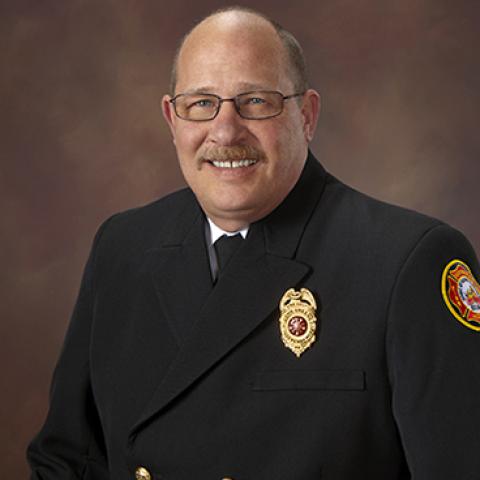
Chief John Greene was Interim Fire Chief until officially appointed to the position in August of 2014. He was the first Chief since Lester Merrill, to be promoted through the ranks of IFD, having held every rank on the fire department from Firefighter to Fire Chief. Chief Greene was able to operate each shift to full capacity, and no longer needed to shut down apparatus or change pumpers to rescues. Chief Greene’s tenure was relatively short, lasting just under 3 ½ years. He retired on Christmas Day, 2017.
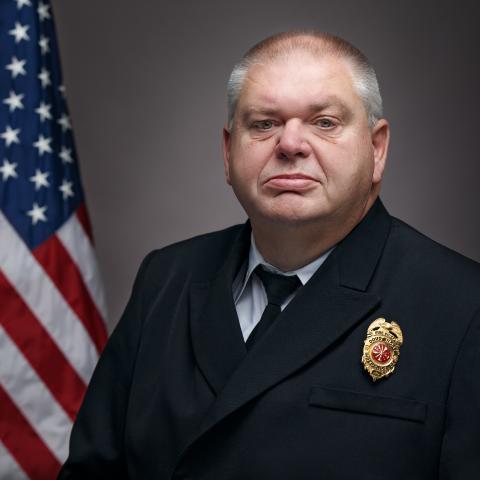
Douglas Short was promoted to Fire Chief the day after Christmas, 2017, in what appeared to be a smooth transition. IFD celebrated its 175th anniversary throughout 2018, which was memorialized with special IFD t-shirts and replica 1840’s badges that could be worn with the uniform. The first two years of his tenure seemed “business as usual”, and Chief Short had a vision for the fire department, moving into the future. “Business as usual” and future planning came to a screeching halt in March of 2020, when the Covid-19 pandemic shut down the entire country. Chief Short was appointed as the Covid -19 Incident Commander for the City during the
pandemic, developing a response plan for not only IFD, but also the entire City government. He established and ran the Covid-19 vaccination clinic which provided thousands of Covid-19 vaccines for at-risk citizens and later for any who chose to receive the vaccine.
During this same period, IFD experienced loss on a monumental scale, with the passing of David Jameson, Michael Stitt, Chad Sappenfield and Harold “Gene” Eddins. Each loss hit the Fire Department very hard, and in their own unique way. This was a dark period for the Independence Fire Department. With a lot of help, Chief Short was able to navigate the Independence Fire Department through a pandemic that lasted nearly three years, and the passing of four beloved Firefighters, while also playing a major role in the City’s response plan for Covid-19. Through all of this, Chief Short was able to maintain his vision for IFD’s future.
In April of 2023, after years of data collection and a lengthy third-party study, Chief Short was able to unveil and implement the fire department’s strategic response plan. The City of Independence had experienced a lot of growth in the previous 30 years, in both population and call volume. IFD ran roughly 12,500 calls in 2004, compared to running over 26,500 calls in 2022, and was still operating with the same number of stations, apparatus and personnel that existed in the mid 1990's. The study revealed that the Fire Department needed to add another station, another apparatus, and more personnel, to meet the needs of the ever-changing Independence community. Apparatus were relocated for the purpose of call sharing in busier districts, and a new unit was created, increasing the number of multi-company stations from two to five. Plans are in the works to add Station 11, rebuild Station 8, purchase several new apparatus, and increase the number of personnel. On July 28, 2023, just three months after initiating the strategic response plan, Chief Short retired.
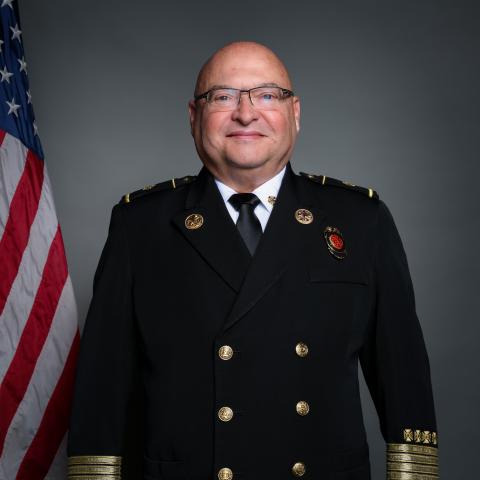
Four days later, City Manager Zach Walker announced the appointment of Chuck Lauss as Interim Fire Chief. Chief Lauss was brought in after his retirement from a long career with multiple fire departments in central Illinois. His intentions were to be the Interim Fire Chief for as long as necessary, while the city conducted a nationwide search for a new Chief. During his tenure, Chief Lauss continued to move forward with the Fire Department’s strategic response plan and was an integral part in the transitions IFD has been experiencing.
On June 24, 2024, Jimmy Walker was appointed as the Fire Chief of the Independence Fire Department. Chief Walker earned his position after a grueling process in which several quality fire chiefs from around the country participated. He comes to IFD with over 28 years of experience with the Kansas City, MO Fire Department. Chief Lauss has agreed to stay on, until August 1, 2024, which will mark his one-year anniversary with IFD, to assist Chief Walker in assuming his new role. We are anxious to see what the future has in store for Chief Walker, IFD and the City of Independence. 2024 marks 181 years of service for the Independence Fire Department.
